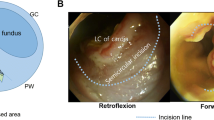Abstract
Background
The use of radiofrequency energy (RFe) treatment at the gastroesophageal junction (GEJ) has been considered an alternative to surgery after fundoplication disruption. It is unknown whether the recommended delivery technique for primary gastroesophageal reflux disease applies to an anatomically altered GEJ following fundoplication. The aim of this study was to determine whether modifications to the standard technique using fluoroscopic guidance more accurately localizes ablation zones compared with standard technique alone.
Methods
Ten pigs were randomized to either conventional or fluoroscopically guided RFe ablation. All pigs had a laparoscopic Nissen fundoplication that was subsequently disrupted by severing all but the most cranial fundoplication stitch. Conventional RFe delivery included usage of markers located on the Stretta catheter. After labeling the z-line via submucosal contrast injection, fluoroscopic guidance involved using fluoroscopic markers to guide RFe ablation. Ablations were acutely marked, measured, and agreed upon by a panel of three researchers analyzing harvested tissue. Distances from the target zone for each ablation line (e.g., 1 cm was the target zone for line 1) were calculated and analyzed using Mann-Whitney and Fischer’s tests.
Results
Fluoroscopic guidance was significantly more accurate than the conventional technique (0.2 ± 0.2 cm vs. 1.8 ± 0.8 cm, p < 0.0001). Analyzing the individual distances for each of the six ablation lines revealed that all within Group B were closer than Group A (p < 0.01 for all except lines 1 and 2). Overall, the total ablation treatment length for conventionally treated animals was 4.48 ± 0.7 cm and for those who underwent fluoroscopic guidance it was 2.92 ± 0.5 cm (p < 0.001).
Conclusion
In a porcine model of fundoplication disruption, fluoroscopic guidance improved RFe accuracy.




Similar content being viewed by others
References
Burmeister BH (2001) Localization of small esophageal cancers for radiation planning using endoscopic contrast injection: report on a series of eight cases. Dis Esophagus 14: 28–31
Corley DA, Katz P, Wo JM, Stefan A, Patti M, Rothstein R, Edmundowicz S, Kline M, Mason R, Wolfe MM (2003) Improvement of gastroesophageal reflux symptoms after radiofrequency energy: a randomized, sham-controlled trial. Gastroenterology 125: 970–973
Dellemagne B, Weerts JM, Jeahes C, Markiewics S (1998) Results of laparoscopic Nissen fundoplication. Hepatogastroenterology 45: 1338–1343
Flum DR, Koepsell T, Heagerty P, Pelligrini CA (2002) The nationwide frequency of major adverse outcomes in antireflux surgery and the role of surgeon experience, 1992–1997. J Am Coll Surg 195: 611–618
Hinder RA (2000) Surgical therapy for GERD. Selection of procedures, short- and long-term results. J Clin Gastroenterol 30(Suppl): S48–S50
Horgan S, Pohl D, Bogetti D, Eubanks T, Pelligrini C (1999) Failed antireflux surgery. What have we learned from reoperations? Arch Surg 134: 809–815
Hunter JG, Smith CD, Branum GD, Waring JP, Trus TL, Cornwell M, Galloway KD (1999) Laparoscopic fundoplication failures. Patterns of failure and response to fundoplication revision. Ann Surg 230: 595–604
Curon Medical Inc. (2002) The Stretta Procedure. Endoluminal delivery of temperature-controlled radiofrequency energy for the treatment of gastroesophageal reflux disease. Procedure summary, patient selection, clinical data Version August 15, 2002
Kahrilas P, Pandolfino J (2003) The target of therapies: pathophysiology of gastroesophageal reflux disease. Gastrointest Endosc Clin North Am 13: 1–17
Kim MS, Dent J, Holloway R, Utley DS (2000) Radiofrequency energy delivery to the gastric cardia inhibits triggering of transient lower esophageal sphincter relaxation in a canine model [abstract]. Gastroenterology 188: AB4790
Pandolfino J, Shi G, Curry J, Joehl R, Brasseur J, Kahrilas P (2002) Esophagogastric junction distensibility: a factor contributing to sphincter incompetence. Am J Physiol Gastrointest Liver Physiol 282: G1052–G1058
Raijman I, Kortan P, Haber GB, Marcon NE (1994) Contrast injection to identify tumor margins during esophageal stent placement. Gastrointest Endosc 40: 222–224
Soper NJ, Dunnegan D (1999) Anatomic fundoplication failure after laparoscopic anti-reflux surgery. Ann Surg 229: 669–677
Stein HJ, Feussner H, Siewer JR (1996) Failure of antireflux surgery: causes and management strategies. Am J Surg 171: 36–39
Triadafilopoulos G, Utley DS (2001) Temperature-controlled radiofrequency energy delivery for gastroesophageal reflux disease: the Stretta procedure. J Laparoendosc Adv Surg Tech 11: 333–339
Triadafilopoulos G, DiBaise JK, Nostrant TT, Anderson PK, Wolfe MM, Rothstein RI, Wo JM, Corley DA, Patti MG, Antignano LV, Goff JS, Edmundowicz SA, Castell DO, Rabine JC, Kim M, Utley DS (2002) The Stretta procedure for the treatment of GERD: 6 and 12 month follow-up of the U.S. open label trial. Gastrointest Endosc 55: 149–156
Utley DS, Kim M, Vierra MA, Triadafilopoulos G (2000) Augmentation of lower esophageal sphincter pressure and gastric yield pressure after radiofrequency energy delivery to the gastroesophageal junction: a porcine model. Gastrointest Endosc 52: 81–86
Author information
Authors and Affiliations
Corresponding author
Rights and permissions
About this article
Cite this article
McClusky, D.A., Khaitan, L., Gonzalez, R. et al. A comparison between fluoroscopically guided radiofrequency energy delivery and conventional technique in an animal model of fundoplication failure. Surg Endosc 21, 1332–1337 (2007). https://doi.org/10.1007/s00464-007-9204-1
Received:
Accepted:
Published:
Issue Date:
DOI: https://doi.org/10.1007/s00464-007-9204-1




